
Insects in the family Tettigoniidae are commonly called katydids or bush crickets. They have previously been known as "long-horned grasshoppers". More than 8,000 species are known. Part of the suborder Ensifera, the Tettigoniidae are the only extant (living) family in the superfamily Tettigonioidea.

The speckled bush-cricket is a flightless species of bush-cricket belonging to the family Tettigoniidae. The species was originally described as Locusta punctatissima in 1792.

Tettigonia viridissima, the great green bush-cricket, is a large species of bush-cricket belonging to the subfamily Tettigoniinae.
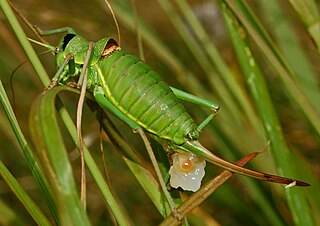
Ephippiger is a genus of Palaearctic bush crickets described by Berthold in 1827, belonging to the family Tettigoniidae, subfamily Bradyporinae and tribe Ephippigerini.

Metaplastes pulchripennis, common name Italian ornate bush-cricket, is a species of 'katydids crickets' belonging to the family Tettigoniidae subfamily Phaneropterinae.

Phaneroptera nana, common name southern sickle bush-cricket, is a species in the family Tettigoniidae and subfamily Phaneropterinae. It has become an invasive species in California where it may be called the Mediterranean katydid.

Tylopsis lilifolia, the lily bush-cricket, is a species of Orthopterans in the subfamily Phaneropterinae. It is found in Europe and Asia.

Yersinella raymondii, common name Raymond's bush-cricket, is a species of "katydids crickets" belonging to the family Tettigoniidae subfamily Tettigoniinae. The scientific name Yersinella comes from the name of the entomologist who has described the species in 1860.

Conocephalus fuscus, the long-winged conehead, is a member of the family Tettigoniidae, the bush-crickets and is distributed through much of Europe and temperate Asia. This bush-cricket is native to the British Isles where it may confused with the short-winged conehead. These two species are phenotypically similar; however, the distinguishing factor between the two is the fully developed set of wings the long-winged conehead possesses that allows for flight. In the short-winged coneheads the hind wings are shorter than the abdomen, causing the wings to be vestigial and the species is incapable of flight. For this reason it is hard to discriminate between the two species during the early stages of their life cycle before the wings have fully developed. The colouration of the conehead is typically a grass green with a distinctive brown stripe down its back, though there are some brown phenotypes.

Barbitistes obtusus, the southern saw-tailed bush-cricket or Alpine saw bush-cricket, is a species of bush crickets in the subfamily Phaneropterinae.

Ephippiger provincialis, the Provence saddle-backed bush cricket, is a species in the family Tettigoniidae.

Antaxius pedestris is a species of "bush crickets" belonging to the family Tettigoniidae. It was originally described by Johan Christian Fabricius under the scientific name of Locusta pedestris.
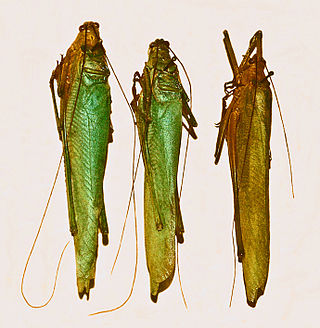
Zeuneria melanopeza is a species of insect in the family Tettigoniidae subfamily Phaneropterinae.
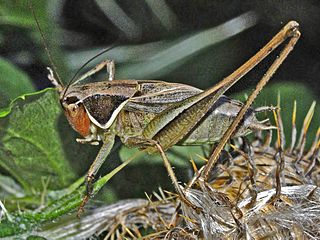
Sepiana sepium, common name sepia bush-cricket, is a species of bush crickets belonging to the tribe Platycleidini and genus group Platycleis. It is the only species within the monotypic genus Sepiana.

Leptophyes laticauda is a species of bush-crickets belonging to the family Tettigoniidae.

Ephippiger ephippiger, the saddle-backed bush cricket, is a species belonging to the family Tettigoniidae subfamily Bradyporinae. It is found in all of Europe except the British Isles. but it is only common in Southwest Europe. The habitat consists of relatively dry and sparse areas with scarce vegetation, such as heather with a few trees, where it can be found both close to the soil and higher up in the vegetation. The saddle-backed bush cricket mainly eats insects and other small animals, but also plant parts. For arable farmers, it is a useful animal because it lives in plants but mainly hunts for plant-dwelling (pest) insects. It is active during the months of August to October; the males are mainly heard between eleven o'clock in the morning and nine o'clock in the evening. The sound is clearly audible and consists of a sharp, grating squeak that sounds like tieh, but is repeated in long runs with a frequency of about one or two times per second.
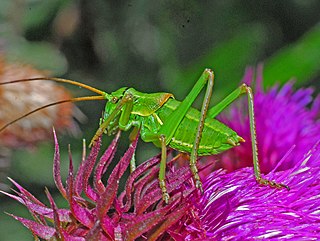
Ephippiger terrestris, common name Alpine saddle-backed bush-cricket, is a bush cricket species belonging to the family Tettigoniidae, subfamily Bradyporinae.
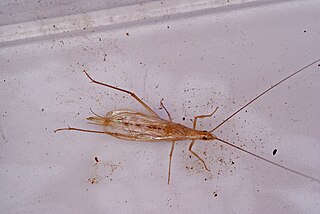
Oecanthus dulcisonans is a species of cricket sparsely but widely distributed in the Mediterranean Basin and in the Middle East.
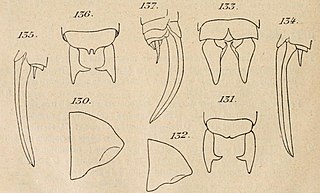
Conocephalus conocephalus is the type species of the conehead genus Conocephalus and the bush cricket tribe Conocephalini. This species has been recorded from southern Europe, including France, and Africa. Described by Carl von Linné in 1767, C. conocephalus appears to have no surviving type specimens, although it is believed that material may have been obtained from Africa.
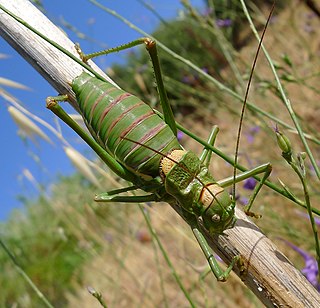
Steropleurus is a genus of European bush crickets in the tribe Ephippigerini, first described by Ignacio Bolívar in 1878. as Ephippiger (Steropleurus). To date (2022), species have only been recorded from the Iberian peninsula.





















